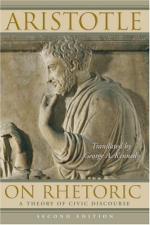
|
| Name: _________________________ | Period: ___________________ |
This quiz consists of 5 multiple choice and 5 short answer questions through Book III, Chapters 1-9.
Multiple Choice Questions
1. What did Aristotle think the structure of a sentence should always be?
(a) Clear.
(b) Simple.
(c) Detailed.
(d) Implied.
2. In what type of person did Aristotle explain there was an especially strong temptation to commit crimes?
(a) Someone that was unaware of the punishment for committing a crime.
(b) Someone that has already committed a crime and has been caught, but not convicted.
(c) Someone that has never committed a crime.
(d) Someone that has already committed a crime, but has not been caught.
3. What was thought to be incorrect about the example of the misuse of the epithet that Aristotle provided?
(a) An extraordinary verb was applied to an ordinary noun.
(b) An ordinary verb was applied to an extraordinary noun.
(c) An extraordinary adjective was applied to an ordinary noun.
(d) An ordinary adjective was applied to an extraordinary noun.
4. How did Aristotle differentiate between crime and punishment?
(a) Crime was immediate while punishment was remote.
(b) Crime and punishment were remote.
(c) Crime and punishment were immediate.
(d) Crime was remote while punishment was immediate.
5. Based on Aristotle's explanation of the wealthy, how did wealthy people view the opinions of others about money?
(a) They thought that everyone disagreed with their view of money.
(b) They thought that most people understood their view of money, but did not understand the reasons for it.
(c) They thought that most people were incapable of understanding their view of money.
(d) They thought that everyone shared their view of money.
Short Answer Questions
1. Which characteristic did Aristotle think separated powerful people and wealthy people in general?
2. According to Aristotle, what was the general difference between enthymemes and examples?
3. According to Aristotle, how was the structure of text conveyed in the periodic prose?
4. What did Aristotle think orators should be careful of when writing their speeches?
5. As explained by Aristotle in Book I, Chapter 10, what was the concern of the legal rhetorician?
|
This section contains 426 words (approx. 2 pages at 300 words per page) |

|




